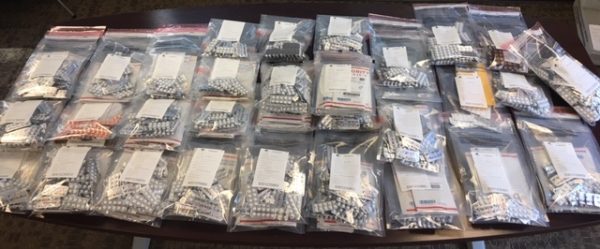
An operation by the Drug Enforcement Administration and other federal agencies, including the U.S. Postal Inspection Service, Bureau of Alcohol, Tobacco, Firearms and Explosives, and Homeland Security Investigations has turned up a previously undocumented drug problem spread across Alaska. The DEA estimates that more than a million pills of tramadol, a mild opioid, are reaching Alaska a year, arriving primarily in rural communities through the mail system. The investigation into illicit tramadol is an outgrowth of the Justice Department’s declaration this summer of a public safety emergency for Alaska.
On a recent weekday in the DEA’s midtown office, a table was covered in Ziploc bags stuffed with pharmaceutical packages of tramadol, the flat, white disks resembling breath mints. Beside them were piles of red and white flat-rate mail envelopes.
“Just tons of packages like this,” said Special Agent in Charge Keith Weis.
For 45 days this summer, the DEA launched a “surge” across the state. It was a multi-pronged effort that included, among other things, an operation in Anchorage between the DEA and partner agencies seizing 204 packages containing almost 48,545 illicit or unlawfully diverted pills. Almost all of those pills — 44,580 — were tramadol.
“Our intelligence has always told us that tramadol is a large problem for the entire state of Alaska. It’s an underlying drug that’s being shipped in at will, especially via mail,” Weis said.
Tramadol is a Schedule IV drug, less tightly regulated than stronger opioid painkillers like oxycodone, but it works largely the same way. It has a mild narcotic high, and can help mitigate withdrawal symptoms for heavier opioid or heroin users. It’s also widely used in veterinary care. Many Alaskans heard about tramadol for the first time in 2017 when some of Iditarod champion Dallas Seavey’s sled dogs tested positive for it (Seavey was cleared of any wrongdoing).
Based on DEA’s interdiction operation this year, Weis estimates around 100,000 pills are arriving in Alaska every month.
“It was dispersed over the whole state,” Weis said of where parcels were bound for. “It was widespread, which tells us it’s out there and pretty deeply seeded in all the communities.”
Taking higher doses of tramadol can cause seizures and depressed breathing, and is especially dangerous if used in combination with other drugs.
The investigation came as a result of Attorney General William Barr’s June visit to Alaska, after which time he declared an emergency over the lack of rural law enforcement and public safety. That move has brought more money into the state for hiring, new equipment, and additional training. But it also spurred federal agencies to take a more active role in rural areas. The other pieces of DEA’s “surge” were bringing a plane up to Alaska so personnel could fly to 35 different communities: villages, hubs, cities and small towns along the Railbelt. A map on the wall was scattered with red dots marking every site where the group flew. There, they met with elders, leaders and law enforcement personnel, made presentations at schools and visited staff who handle prescribing medications in local clinics. The Agency hopes those introductions will foster longer-term relationships with rural communities to better handle drug issues.
And the DEA isn’t the only agency doing that kind of work right now.
Federal prosecutors are trying to find ways to help local and state law enforcement build more criminal cases in rural areas.
“We’re looking for ways to do more,” said U.S. Attorney Bryan Schroder. “To fill an appropriate role out there.”
That may mean using legal tools uniquely available to federal prosecutors, like felons found in possession of firearms, drug trafficking, or certain kinds of cases involving child pornography. The Justice Department is hiring three new prosecutors for Alaska, and a grant is paying for two more state assistant district attorneys, all of whom will be focused on cases in rural parts of the state.
On a recent trip to Kodiak with the DEA, Schroder was moved by a meeting with native leaders from surrounding communities.
“What struck me was how much concern there was by those leaders about drug problems in their villages,” Schroder said. “I don’t know that I was quite ready for that. There were people who were getting very emotional about the damage drugs are doing to their villages.”
The rekindled interest among federal law enforcement agencies comes as a statewide conversation is underway about the shortcomings of public safety and the criminal justice system in Alaska.
Zachariah Hughes reports on city & state politics, arts & culture, drugs, and military affairs in Anchorage and South Central Alaska.
@ZachHughesAK About Zachariah




